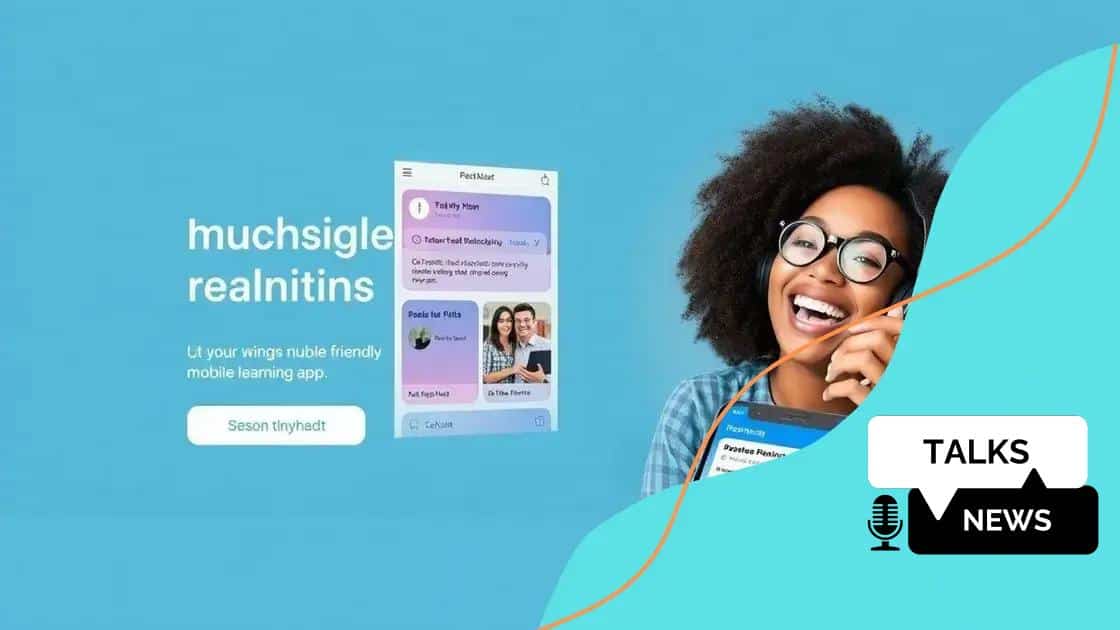Mobile learning applications for distance education

Mobile learning applications enhance distance education by providing flexible, accessible, and engaging learning experiences, while addressing challenges like technical issues and user engagement through interactive features and strong security measures.
Mobile learning applications for distance education are transforming how we learn remotely. Have you ever wondered how these tools could impact your educational experience? Let’s dive into the world of mobile learning and explore its potential.
The rise of mobile learning applications
The world has seen a rapid increase in the use of mobile learning applications. This shift is changing how students engage with educational materials. In recent years, more learners have embraced this format due to its convenience and accessibility.
Why Mobile Learning?
Students today are looking for tools that fit into their busy lifestyles. With mobile learning applications, education is just a tap away, making learning more flexible. Students can study from anywhere at any time, which is a significant advantage.
Key Benefits of Mobile Learning Applications
- Accessibility: Users can access courses and resources on the go.
- Engagement: Interactive features keep students motivated.
- Personalization: Adaptive learning paths cater to individual needs.
- Affordability: Many apps offer low-cost or free options, making learning accessible to everyone.
The rise of mobile learning applications is also fostering global education. As individuals gain access to high-quality resources, education becomes more inclusive. This is important for communities where traditional schooling may not be easily available.
Moreover, mobile learning applications allow educators to share knowledge in innovative ways. For example, they can provide real-time feedback, enhancing the overall learning experience. By promoting collaboration among students, these applications create a more connected learning environment.
Future of Mobile Learning
Looking ahead, the significance of mobile learning applications will only grow. As technology advances, we can expect even more features that will enhance remote learning. By embracing these changes, students and educators can adapt to new educational landscapes.
Benefits for distance education
Distance education offers many benefits that can enhance the learning experience for students. As technology continues to improve, more people are choosing this flexible approach to education.
Flexibility and Convenience
One of the main advantages of distance education is its flexibility. Students can choose when and where they want to study. This is ideal for those who have jobs, family commitments, or other obligations. With the right manual, learners can balance their studies with their personal lives.
Accessibility for All
Distance education breaks geographical barriers. Students from remote areas can access high-quality resources and courses that may not be available locally. This ensures a more inclusive educational environment, allowing diverse groups of learners to participate.
Cost-Effectiveness
Another significant benefit is cost savings. Distance education often has lower tuition fees compared to traditional schools. Additionally, students save on commuting and housing expenses. This makes it an attractive option for many individuals.
- Lower tuition fees: Many online programs are less expensive.
- No travel costs: Students can learn from home.
- Flexible payment options: Various financial aid opportunities are available.
The technological tools used in distance education also provide interactivity. With features like forums, live chats, and multimedia materials, students can engage actively with their courses. This promotes a sense of community, which can sometimes be lacking in traditional settings.
Moreover, these applications often allow for personalized learning experiences. Students can progress at their own pace, reviewing materials as needed and focusing on areas of interest. This self-directed approach to learning empowers students and can lead to better retention of knowledge.
Enhanced Learning Experience
Ultimately, the benefits of distance education contribute significantly to a better overall learning experience. More students are realizing the positive impact of this approach on their academic journeys.
Key features of effective mobile learning apps

Effective mobile learning apps possess several key features that enhance the learning experience for users. By incorporating these elements, developers can create applications that are not only user-friendly but also highly engaging.
User-Friendly Interface
An intuitive interface is essential for any successful mobile learning app. Users should easily navigate through the app without confusion. Clear menus and straightforward layouts help students focus on their studies rather than struggling with technology.
Interactive Learning Tools
Effective mobile learning apps must offer interactive tools to keep students engaged. Features such as quizzes, flashcards, and gamified learning experiences can make the process enjoyable. These tools also promote active learning and help reinforce knowledge.
- Quizzes: Short assessments help users gauge their understanding.
- Multimedia content: Videos and animations can explain complex concepts.
- Discussion forums: Users can interact with peers, enhancing collaboration.
Another important aspect is personalized learning pathways. This means that users can tailor their educational experiences based on their interests and levels of understanding. By using data analytics, apps can recommend content suited to individual learning styles.
Offline Accessibility
Offline access is another critical feature of effective mobile learning apps. Students should be able to download materials for studying without requiring an internet connection. This is especially important for learners in areas with limited connectivity. It ensures that education remains uninterrupted, allowing for continuous learning.
Gamification elements can also enhance engagement. Incorporating rewards, levels, and challenges can motivate users to complete courses and stay committed to their studies. This approach keeps learners interested while promoting a sense of achievement.
Regular Updates and Improvements
Lastly, regular updates are crucial for maintaining the effectiveness of mobile learning apps. Developers should incorporate user feedback for continuous improvements. This ensures that the app remains relevant and meets the evolving needs of learners.
Case studies: Success stories in mobile learning
Numerous success stories illustrate the positive impact of mobile learning applications. These case studies showcase how various educational institutions and businesses have harnessed mobile technology to enhance learning outcomes.
University of Maryland
The University of Maryland implemented a mobile learning app for its students, offering access to course materials anytime, anywhere. The app includes features like video lectures, interactive quizzes, and forums for peer discussion. As a result, student engagement increased significantly, with many reporting better comprehension of subject matter.
Duolingo
Duolingo is a popular language-learning app that uses gamification to motivate users. By incorporating game-like elements, such as earning points and leveling up, it keeps learners engaged. The app reported that over 30 million users practice daily, demonstrating the effectiveness of a mobile-first approach to language education.
- Interactive lessons: Bite-sized content that is easy to digest.
- Community engagement: Users connect with friends for added motivation.
- Personalization: The app adapts to each learner’s pace.
Another noteworthy case is the use of mobile learning in corporate training at companies like McDonald’s. The fast-food giant developed a mobile app that provides training modules for employees. This app helps employees learn procedures efficiently while on the job, leading to improved service quality and faster training times.
Edmodo
Edmodo, an educational platform that integrates mobile learning, connects teachers, students, and parents. With its mobile app, teachers can easily share assignments, grade work, and communicate with students. This systematic approach to collaboration helps keep everyone informed and engaged in the educational process.
Each of these case studies highlights the transformative potential of mobile learning applications. By providing tools that foster engagement, personalization, and effective communication, they create more accessible and effective learning environments.
Challenges and solutions in mobile learning
While mobile learning has transformed education, it also presents several challenges. Understanding these issues is essential for developing effective solutions that enhance the learning experience.
Technical Issues
Many students face technical problems when using mobile learning apps. Issues such as slow internet connections or device compatibility can hinder access to educational content. To address this, developers should prioritize optimization for various devices and ensure that apps function smoothly even on slower networks.
User Engagement
Another significant challenge is maintaining user engagement. With countless distractions available on mobile devices, students may find it hard to focus. To combat this, educational apps must incorporate interactive elements such as quizzes and games. By making learning fun and engaging, apps can help retain users’ attention.
- Incorporate gamification: Reward users for completing tasks.
- Push notifications: Remind users of upcoming lessons or deadlines.
- Social features: Encourage users to connect with peers for collaborative learning.
Accessibility is also a crucial aspect of mobile learning. Students with disabilities may struggle to use some apps if they are not designed inclusively. Developers should follow accessibility guidelines to create apps that accommodate all learners. Features like screen readers and adjustable text sizes can significantly improve usability.
Content Quality
The quality of educational content available through mobile learning apps can vary greatly. Some resources may be outdated or not aligned with educational standards. To ensure high-quality learning materials, it is crucial to collaborate with educators and subject matter experts during the content development phase.
Another challenge involves data privacy and security. As more students rely on mobile learning applications, safeguarding personal information becomes a priority. Developers must implement robust security measures, including encryption and compliance with data protection regulations to protect user data.
Continuous Digital Literacy
Lastly, ensuring that both educators and students possess the necessary digital literacy skills is vital. Providing training or resources on how to use mobile learning apps effectively will empower users to maximize their educational benefits. Online tutorials or workshops can bridge this knowledge gap, making mobile learning accessible to everyone.
FAQ – Frequently Asked Questions about Mobile Learning Applications
What are the key benefits of mobile learning applications?
Mobile learning applications provide flexibility, accessibility, and personalized learning experiences, making education more engaging and easier to access.
What challenges do users face with mobile learning?
Users may experience technical issues, lack of engagement, and accessibility challenges, which can hinder the learning experience.
How can developers improve user engagement?
By incorporating interactive features like quizzes, gamification, and social elements, developers can keep learners interested and motivated.
Why is data privacy important in mobile learning?
Ensuring data privacy protects users’ personal information and builds trust, which is crucial for the success of mobile learning applications.





